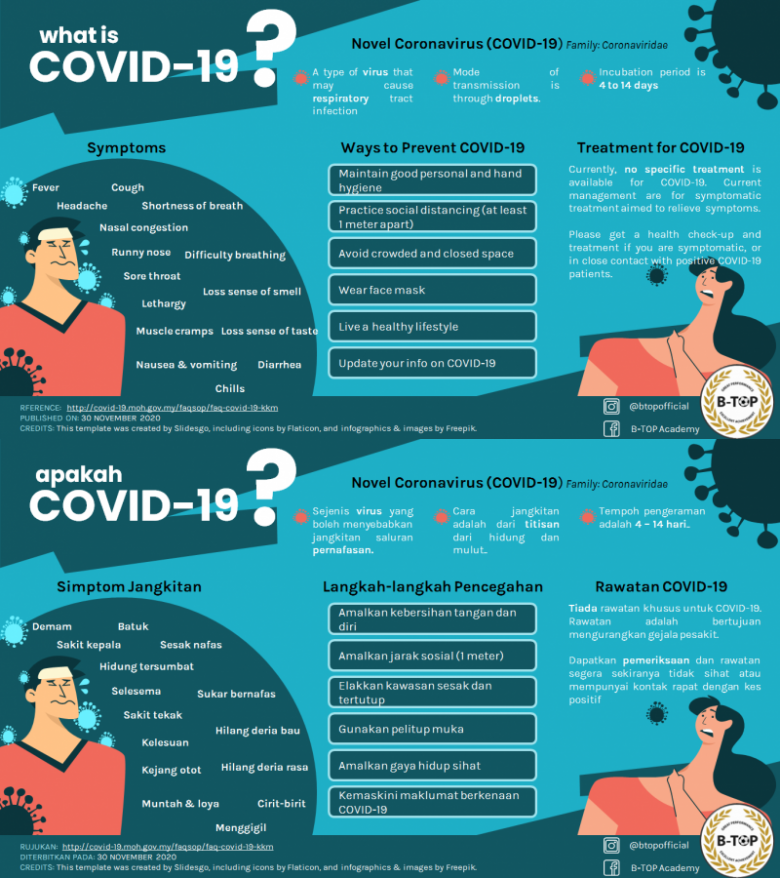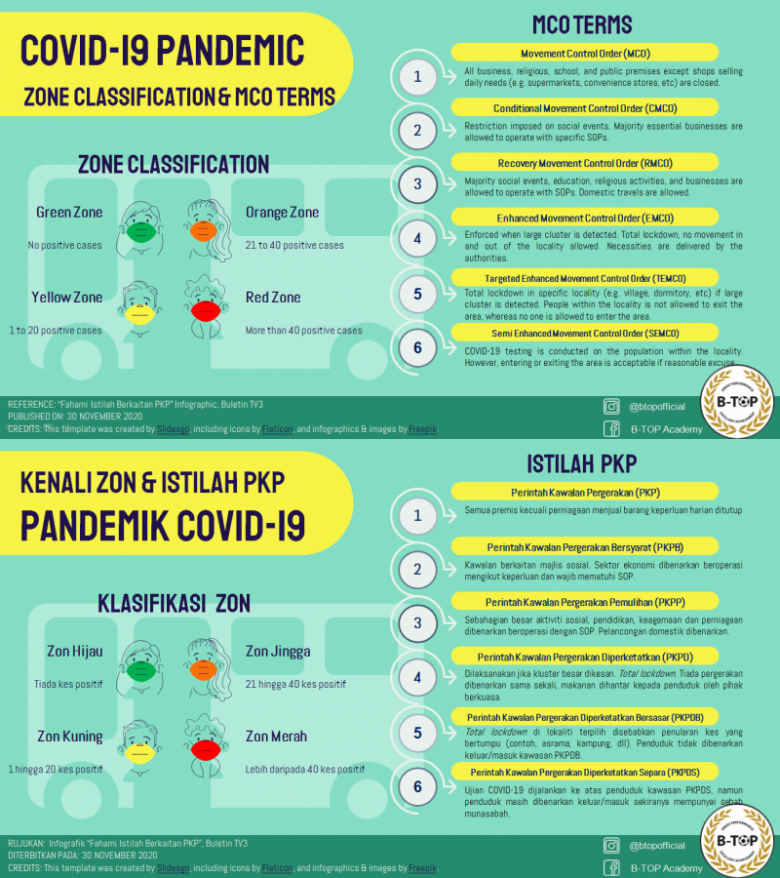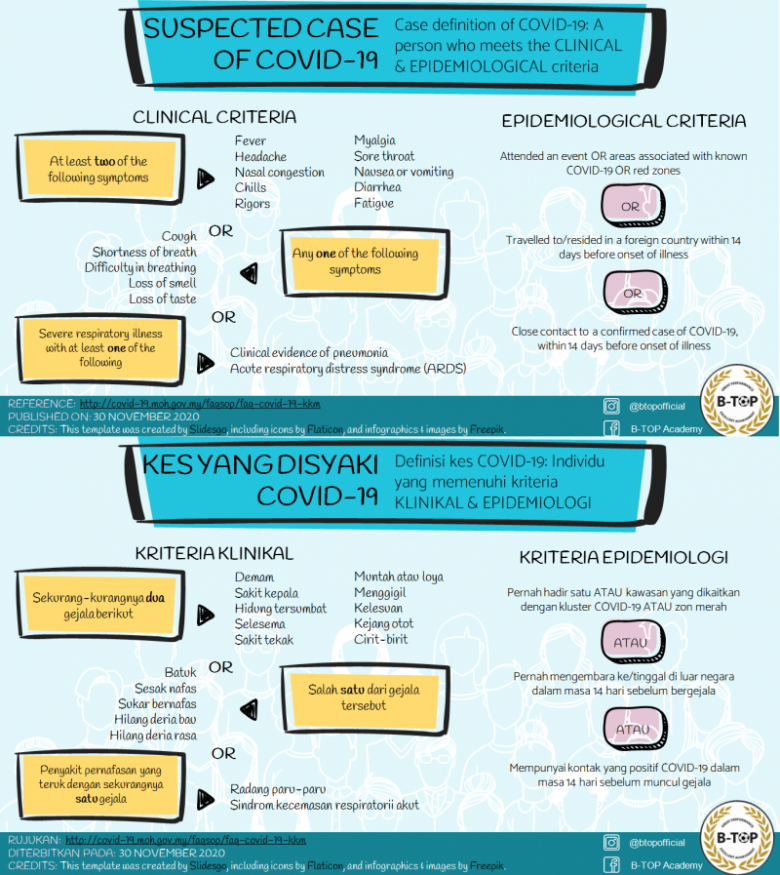WHAT IS COVID-19?
The novel coronavirus 2019 (COVID-19) is a virus from tbe coronaviridae family that causes respiratory tract infection, similar with Sever Acute Respiratory Syndrome (SARS) and Middle East Respiratory Syndrome-related Coronavirus (MERS-CoV). The virus spreads through droplets from nasal discharge and saliva, via cough or sneeze. The droplets on the objects’ surfaces may in turn infect others if in contact and no precaution on hand hygiene taken.
The first ever COVID-19 was detected in end of 2019, and was confirmed on 7th January 2020 in Wuhan, Hubei Province, China. Whereas the first case of COVID-19 in Malaysia was confirmed on 25th January 2020.
WHAT IS PANDEMIC?
COVID-19 managed to infect millions of people around the globe, therefore WHO announced the COVID-19 pandemic. A pandemic is defined as an outbreak occurring worldwide, or over a very wide area crossing international boundaries and usually affecting a large number of people. Other prominent examples of pandemic throughout the human history are the Bubonic Plague (1347-1919), Smallpox (1520), the Spanish Flu (1918-1919), and HIV/AIDS (1981-present). To this date (November 2020), Malaysia has entered the third wave of COVID-19 in view of drastic increase of COVID-19 cases.

WHAT DOES THE ZONES MEAN?
KKM has introduced colour classification of localities according to the number of positive cases, whereby:
i. Green Zone – No positive cases
ii. Yellow Zone – 1 to 20 positive cases
iii. Orange Zone – 21 to 40 positive cases
iv. Red Zone – more than 40 positive cases
EMCO will be enforced to the locality if classified as red zone.
WHAT ARE THE MCO TERMS?
Enforcement of MCO was done as a preventive measure by the federal government of Malaysia in response to the COVID-19 pandemic. Numerous terms of MCO were introduced to tailor according to the progress of cases outbreak. Simplified elaborations of each terms are as below:
1. Movement Control Order (MCO)
- Implemented on 18th March – 3rd May 2020.
- All business, religious, school, and public premises are closed except shops selling daily needs such as supermarkets, convenience stores, etc.
2.Conditional Movement Control Order (CMCO)
- Implemented on 4th May – 9th June 2020.
- CMCO focus on restriction of social events and activities, whereas majority of businesses that are deemed essential are allowed to operate following certain SOPs.
- Entering and exiting CMCO locality is not allowed.
3. Recovery Movement Control Order (RMCO)
- Implemented on 10th June – 31st December 2020
- Majority social events, education, religious gatherings and businesses are conducted as usual following SOPs.
- Domestic travelling is allowed in RMCO.
4. Enhanced Movement Control Order (EMCO)
- EMCO is also known as “total lockdown”. People within the locality where EMCO is enforced are not allowed to go outdoors. Daily necessities such as food are sent door-to-door by the authorities. All businesses within the area are closed during this period, and no travelling is allowed as well.
- EMCO is implemented to a certain locality when a large cluster is detected within the community. EMCO can also be implemented nationwide in light of drastic increase in cases in Malaysia.
5. Targeted Enhanced Movement Control Order (TEMCO)
- TEMCO is almost similar to EMCO, however the total lockdown is applied to a more targeted locality, for example a village, dormitory, et cetera.
- People within the TEMCO area are not allowed to exit the area.
6. Semi Enhanced Movement Control Order (SEMCO)
- COVID-19 testing is conducted on the population within the locality.
- However they are still allowed to enter and exit the area with reasonable excuse.

WHAT ARE THE WAYS OF PREVENTION?
- Maintain good personal and hand hygiene
- Practice social distancing (at least 1 meter apart)
- Avoid crowded and closed space
- Wear face mask
- Live a healthy lifestyle: stay active, eat balanced diet, manage stress well, stop smoking.
- Update your info on COVID-19.
WHO ARE AT HIGHER RISK OF INFECTION?
- Elderly
- Children
- Pregnant women
- Those with chronic diseases (diabetes, hypertension, asthma, cardiovascular diseases)
- Immunocompromised patients (cancer patients, HIV patients, and those receiving chemotherapy)
WHO IS CONSIDERED AS CLOSE CONTACT?
1. Individual that has direct contact with COVID-19 positive cases within 14 days, either:
– within less than 1 meter radius with COVID-19 patient; or
– physical contact with COVID-19 patient.
2. Healthcare providers involved in the treatment of confirmed positive COVID-19 case without wearing complete personal protective equipment (PPE).
3. Individual within 1 meter radius or within an enclosed premise (e.g. office,classroom, shops, etc) with a positive COVID-19 case.
4. Individual travelling with or seated within less than 1 meter radius with a positive COVID-19 case throughout the journey.
DO I HAVE COVID-19?
According to Ministry of Health Malaysia (MOH), a person is suspected to be infected with COVID-19 if they fulfill both clinical and epidemiological criteria

WHAT SHOULD I DO IF I HAVE SYMPTOMS OF COVID-19 OR IS A CLOSE CONTACT TO A POSITIVE CASE?
Get yourself tested and treated in nearby hospital or health facilities. Make sure to follow the SOPs when visiting the hospital, such as wearing face mask, practice social distancing, and practice proper cough and sneeze etiquette.
COVID-19 is commonly tested via nasopharyngeal swab (RT-PCR and RTK Antigen). After the swab, make sure to follow the subsequent quarantine and follow-ups as told by your doctor. Quarantine period is typically up to 14 days due to the incubation period of the virus which is 4 to 14 days.
WHAT ARE THE AVAILABLE TREATMENT AVAILABLE FOR COVID-19 INFECTION?
Unfortunately no curative treatments available. Current treatment is aimed to reduce symptoms and improve quality of life. It is worth mentioning the recent development of vaccines has reached the final stage of clinical trial is a promising solution to this pandemic. Vaccine, however, is a preventive measure to protect those who are not yet infected, and is not used to cure infected patients.
